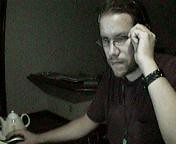Accordingly, I have researched the matter, and it seems nearly universal. So I am led to an inescapable conclusion, that the successful avoidance and resolution of conflict in my future will require my familiarity and skill with the tools and techniques of conflict, which, for the purposes of discussion will involve hostile intelligences of peer level. (The possibility of hostile intelligences of infra-justin level, and super-justin level are fundamentally different problems and require different solutions.(peer level in this case encompasses the multitude of human level opponnents at this point. I see no reason or inclination to expand this range further, as both a dog bent upon my destruction, and a hostile transhuman seem to bear no real insight in mentioning.))
It is helpful to remember and injunction of Nietzche: "When fighting monsters, one must take care not to become a monster oneself". However, in order to fully understand threats, one must delve (perhaps dangerously) into the psychology, and application of violence.
Violence is something human beings and most mammals are very good at, generally. Our evolutionary history is littered with violent adaptations and such nasty things. Interestingly however, the more structured complicated forms of violence that our abstract reasoning allows us to achieve, like wars, terrorism, and taxes appear to follow similar patterns to the more simple mammal to mammal violence our species developed with. Given this surface similarity, investigating the roots of violence leads one to the urge to categorize. I dont' like categorizing, I think axioms and similar nonsense simplify and badly fit the situations one finds oneself experiencing. However, it's occasionally useful to have rules of thumb to apply.
There are seemingly two basic strategies within violence of various brands.
1. Playing to Advantages You Have; This is a relatively straightforward strategy, you have reach, so you stay far, you have money, so you force your opponnent into a bidding war. Forcing the conflict into arenas where you have relative strengths can take many forms, and it behooves you to employ variations on this theme whenever possible, because it increases your applied force, much like a machine of war.
2. Playing to Their Disadvantage; Similarly, the opposite strategem is to force the conflict into arenas where your opponnent has relative weaknesses, such as pressing a lanky opponent into a corner, or shifting the conflict with a generalist to a specific domain where you hold superiority, like commodity trading vs. money markets.
Perversely, stronger opponnents are better off with strategems within 2. Because their greater resource or skill allows them to force opponnents into unwise arenas more easily, with fewer risks. Weaker opponents are better off in 1. as evidenced by the success of forms like Guerrilla warfare, because weak opponnents cannot employ strategies which rely on the stronger opponent to take actions which may endanger the Stronger. The risk of forcing a move is often too costly for a weaker opponent to bear. Context is important. A weaker boxer often plays strategem 2, because boxing is a fluid sport, where forcing moves is relatively simple. Whereas weaker economic powers almost always play 1. because economics moves relatively slowly, and interactions are weaker, making feints and leading motions more difficult to successfully complete.
Keep in mind that the proper application of the knowledge of conflict is to end it. No thinking being deserves suffering, and the most capable party is also the most responsible. Good hunting.
